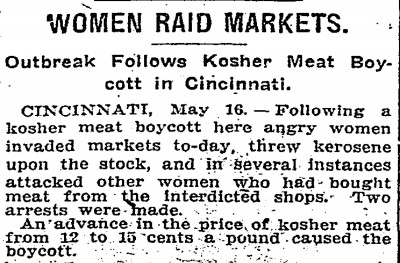Processions, Debates and Curbstone Encounters Part VI

Article by Avi Y. Decter. Originally published in Generations 2011 – 2012: Jewish Foodways.
The boycott of 1910 was one dramatic episode in a twenty-year struggle over kosher meat that engaged meat wholesalers, retail butchers, shochets (ritual slaughterers), the Orthodox rabbinate, and thousands of ordinary Jews, especially in East Baltimore. In the first decades of the twentieth century, conflict over kosher meat was a familiar topic. Today, that contestation is little remembered and poorly documented. However, sufficient evidence survives to give us access to the trajectory and meaning of the protracted struggle over kosher meat. Here is that story.
Part VI: The “Kosher Meat War” of 1910
Missed the beginning? Start here.

The kosher meat boycott of 1910 was initiated, organized, and maintained by Jewish housewives living in East Baltimore. The women leading the strike against kosher meat promoted the eating of fish as a substitute – but their activity went much farther. As shoppers emerged from butcher shops in the Jewish neighborhood, coal oil and gasoline were poured over their purchases. Parcels of meat were seized and thrown in the gutter. Intimidating threats were voiced, pushing and shoving thook place, and arrests ensued.[1] The boycott appears to have been effective: the Baltimore News reported on March 31 that, “For two weeks, the people of the Hebrew colony east of the Jones Falls have been living on eggs, fish and vegetables.”[2] Th further pressure the local wholesale butchers, the boycotters opened three cooperative stores which sold kosher meat shipped in from Chicago.
Meanwhile, the retail butchers and storekeepers seized the opportunity to retaliate against the wholesale butchers. At a meeting on March 24, the retailers determined to boycott their local wholesalers; those retailers who were importing kosher meat from Western suppliers (in defiance of the Orthodox rabbis) “promised to assist in the work by abstaining from purchasing or selling any meat” for two days.[3] A few retailers stayed open, selling locally slaughtered meat at the old, higher prices, but they did little business.[4]
On April 4, a mass meeting that drew 3,000 people was held at the Monumental Theatre. The boycotters resolved unanimously “to keep up the fight to the bitter end: against “the Kosher Meat Trust of this city.” By patronizing only the three cooperative shops that were selling Chicago meat, the boycotters hoped to force down the price of meat.[5] The early arrival of Passover that year underlined the potential for losses among those in the kosher meat industry.
Continue to Part VII: A Continuing Struggle
Notes:
[1] “Coal Oil is Weapon in Anti-Kosher War,” Baltimore News, 23 March 1910. “Boycotters Use Gasoline,” Baltimore American, 23 March 1910. “Boycotter Comes to Grief,” Baltimore Sun, 24 March 1910, p. 7. “Another Arrest in Kosher Meat War,” Baltimore News, 24 March 1910.
[2] “Kosher Meat Sold With Police Guard,” Baltimore News, 31 March 1910.
[3] “Boycott On Kosher Meat,” Baltimore Sun, 25 March 1910, p. 5. “Kosher Meat Boycotters Quiet,” Baltimore Sun, 26 March, 1910, p. 9.
[4] “Boycott Fails To Reduce Beef Price,” Baltimore News, 4 April 1910.
[5] “Meat Boycotters Around,” Baltimore Sun, 4 April 1910, p. 14.
